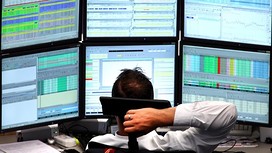© The Financial Times Ltd 2016
FT and 'Financial Times' are trademarks of The Financial Times Ltd.
The Financial Times and its journalism are subject to a self-regulation regime under the FT Editorial Code of Practice.
October 16, 2014 10:40 am
Wall Street’s biggest banks have placed much of the blame for violent swings in US government bond prices over the past 24 hours on new bank safety regulations that they say have reduced market liquidity.
A batch of rules put in place since the 2008 crisis has sought to make banks more resilient, but bank traders and executives have repeatedly warned regulators of a downside: the banks would no longer be able to act as shock absorbers in times of stress.
Bankers and traders said Wednesday’s volatility proved their point, although other analysts said computer-driven trading and other factors were also at play.
“This is reaping what the regulators have sown in terms of changing market structure and making it harder for certain people to warehouse risk,” said a senior executive at one of the top five US banks.
Under the Volcker rule, banks are prohibited from proprietary trading and restricted in their ability to hold securities on their books. Basel III capital rules make it less profitable for them to hold assets. At the same time, the liquidity coverage ratio requires banks hold more cash and more easily sellable securities.
While the first two sets of regulations do not directly affect banks’ ability to warehouse US Treasuries – they are designed to prevent the biggest dealers stockpiling riskier assets – they affect the size of the banks’ overall balance sheets and have led many of them to shrink.
And the LCR has a direct impact on banks’ bond trading: it forces them to hold hundreds of billions of dollars of US Treasuries. These assets cannot be traded, thereby reducing market liquidity.
“A little bit of selling begets a lot of volatility,” said David Ader, strategist at CRT Capital.
“But I think the other issue there and something I have certainly witnessed: it’s not been a very profitable place to be, a fixed income trading desk. People have lost jobs – banks have cut back the risk they’ve been willing to tolerate. Now, today, the number of traders and salesmen on primary dealer desks is probably down a good third.”
With investors scrambling on Wednesday to shift out of riskier assets, such as junk bonds or leveraged loans, and into safe havens such as US Treasuries, the lack of sellers became apparent as the price of the benchmark 10-year veered wildly upwards. Analysts at JPMorgan estimated that market depth fell more than 50 per cent on Wednesday, to a level not seen since the taper tantrum of last year.
“The rally was exaggerated by a sharp drop in liquidity,” the analysts said.
Not everyone agrees.
“I don't see this as a liquidity problem; this is a computer problem,” said Jim Bianco, president and founder of Bianco Research in Chicago.
“What we saw this morning in the Treasury market was a version of the flash crash in stocks a couple of years ago. And that’s what happens when a bunch of computers, programmed by people who have been to the same schools, put the same orders out there. The move was not a result of a group of people deliberately deciding they had to own Treasuries. Computerised trading is not dynamic, and that is a problem.”
Mr Ader said that the sheer volume of investors switching their positions would be difficult for any market to handle. “The number one concern [among investors] has been liquidity in the credit market. The thing that gets them nervous is when they start to underperform. They think with some hubris that they’ll be able to get out. They can’t.”
Still, the bulk of opinion from banks was that the market structure changes wrought by the Federal Reserve, the Treasury and Congress, are playing a part.
The Treasury Borrowing Advisory Committee, one of the main interfaces between the Treasury and both institutional investors and banks, has long warned officials of the dangers of constraining banks from intervening in markets.
Treasury officials were in contact with market participants on Wednesday, according to people familiar with the matter. But one said it was not out of the ordinary given it was one day of volatility.
It is investors capitulating on their belief that rates would rise. There is no sign that officials are capitulating on their belief that banks should not be taking a lot of market risk.
Additional reporting by Camilla Hall in New York, Gina Chon in Washington and Tracy Alloway in Los Angeles and Martin Arnold in London
Copyright The Financial Times Limited 2017. You may share using our article tools.
Please don't cut articles from FT.com and redistribute by email or post to the web.
LAST WEEK’S MOST READ ON FT TRADING ROOM
- Some FANG stocks are still undervalued, says Salesforce CEO Marc Benioff
- Wealth manager offers 4 key financial tips for high school grads
- Fourth of July travelers will see cheapest gas prices in 12 years, GasBuddy says
- Investors want to make an impact, but few actually have a strategy
- Shares of Olive Garden parent pop 4.3% on strong earnings beat
TOOLS & SERVICES
Multimedia
Tools
- Portfolio
- Topics
- FT Lexicon
- FT clippings
- Currency converter
- MBA rankings
- Newslines
- Today's newspaper
- FT press cuttings
- FT ePaper
- Ebooks
- Economic calendar
Services
Quick links
- FT Live
- How to spend it
- The 125
- FT Property Listings
- Social Media hub
- The Banker
- The Banker Database
- Global Risk Regulator
- fDi Intelligence
- fDi Markets
- fDi Benchmark
- Professional Wealth Management
- This is Africa
- Investors Chronicle
- MandateWire
- FTChinese.com
- Pensions Expert
- New York Institute of Finance
- ExecSense
- FT Confidential Research


